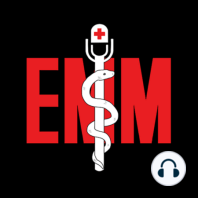2 min listen

On the Streets #9: Advanced Applications of Capnography
On the Streets #9: Advanced Applications of Capnography
ratings:
Length:
72 minutes
Released:
Oct 14, 2020
Format:
Podcast episode
Description
Capnography is the measurement of the partial pressure of exhaled CO2 and is an indirect measurement of your cellular respiration. It is displayed visually as a block-like waveform during the exhalation phase of respiration and monitors ventilation in real-time. Capnography is the gold standard for monitoring sedated and intubated patients in the hospital and the field and can be used in many other situations to discern more information about your patient. Our host Jordan Ourada is joined by Dr. Eric Hill who is a board certified Emergency Physician, EMS Director for 9 agencies around Colorado, a retired military physician with the Army, former paramedic firefighter and combat veteran to discuss advanced applications of capnography to monitor a range of different patients in the pre-hospital setting. Tune in to learn how to apply capnography to monitor your patients and detect serious conditions like sepsis and DKA and initiate time-sensitive interventions that reduce mortality in patients. Quick Educational Pearls: Normal range is between 35 - 45 mmHg Low capnography indicates they are blowing off CO2 High capnography indicates they are retaining CO2 Normal waveform morphology is box-like with gradual expiratory plateau after expiratory upstroke Monitor your patient’s status and interpret the capnography numbers, rate and waveforms accordingly Time Stamps 1:32 Capnography definition 6:36 Normal range 7:40 Reading capnography waveforms 12:36 Capnography monitoring in sedated/intubated patients 13:36 Intubation monitoring 18:03 VQ match vs mismatch 21:42 Asthmatic patients 24:30 Capnography cannula 26:24 Cardiac arrest uses 31:28 Acid-base physiology 37:28 Diabetic patients 40:15 COPD patients 41:42 CHF patients 45:18 Head injury patients 52:07 Sepsis detection and subsequent prehospital management 1:08:15 Closing thoughts on using capnography in the field REFERENCES Brandt, P. “Current Capnography Field Uses.” JEMS. 2010, Nov. DiCorpo,P.,etal.“CapnographyProvidesBiggerPhysiological Picture to Maximize Patient Care.” JEMS. 2015, Nov. Eckstein,M.,etal.“End-tidalCO2asapredictorofsurvivalinout-of- hospital cardiac arrest.” Prehosp Disaster Med. 2011 Jun;26(3):148-50 Kodali,B.“Physicsofcapnography.”2014 Poste,J.,etal.“Airmedicaltransportofseverelyhead-injured patients undergoing paramedic rapid sequence intubation.” Air Med J. 2004 Jul-Aug;23(4):36-40 Davis, D., et al. “Predictors of Intubation Success and Therapeutic Value of Paramedic Airway Management in a Large, Urban EMS System.” Prehospital Emergency Care. 2006: Vol. 10, Iss. 3. Grmec, S. “Comparison of three different methods to confirm endotracheal tube placement in emergency intubation.” Intensive Care Medicine. 2002; 28: 701-4. Silvestri, et al. “The Effectiveness of out of hospital use of continuous end-tidal carbon dioxide monitoring on the rate of unrecognized misplaced intubation within a regional emergency medical services system.” Ann Emerg Med. 2005; 45: 497- 503. Hartman, et al. “Systematic Review and Meta- Analysis of End-Tidal Carbon Dioxide Values Associated With Return of Spontaneous Circulation During Cardiopulmonary Resuscitation.” Journal Intensive Care Med. 2015, Oct;30 (7) 426-35. Levine, et al. “End-tidal carbon dioxide and outcome of out-of-hospital cardiac arrest.” N England J Med. 1997, Jul 31; 337(5): 301-6. AHA 2015 Guidelines Update for Cardiopulmonary Resuscitation and Emergency Cardiovascular Care Science With Treatment Recommendations Hunter CL, et al. “A prehospital screening tool utilizing end-tidal carbon dioxide predicts sepsis and severe sepsis.” American Journal of Emergency Medicine. 2016 May; 34(5):813-819. Bou Chebi, R, et al. “Diagnostic value of end tidal capnography in patients with hyperglycemia in the emergency department.” BMC Emerg Med. 2016 Jan 29; 16:7 Soleimanpour, H, et al. “Predictive value of capnography for suspected diabetic ketoacidosis in the emergency department.” West
Released:
Oct 14, 2020
Format:
Podcast episode
Titles in the series (100)
Salicylate and Camphor Poisoning: A look at a common and not as common chemical that can poison you. by Emergency Medical Minute